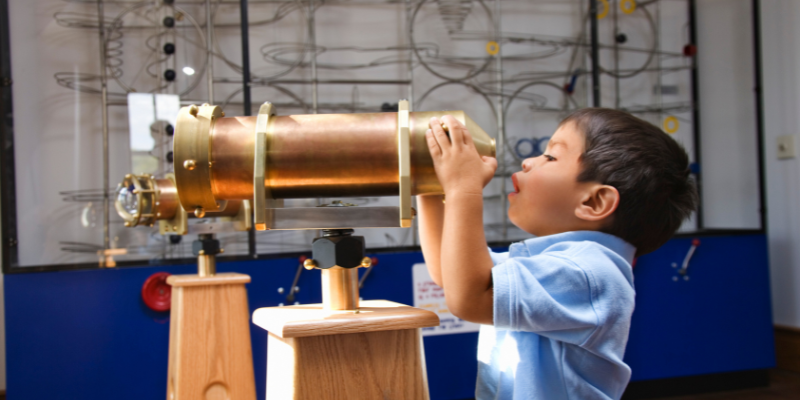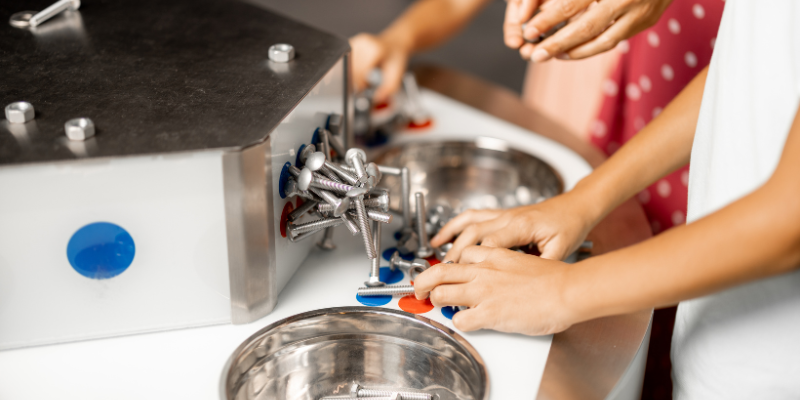What do you think about museums? A big chunk of my career has been spent delivering learning experiences to schools and family groups in museums (particularly natural history). I’ve seen first-hand the impact they can have on students’ understanding, interest, and excitement about a topic so I’m here to spred the word!
Museums have so much to offer to schools and not just in terms of field trips. Here’s my guide to how you can make the most of museums to help you deliver your science or STEM curriculum.
Field trips
First off, museums don’t have to be labeled as ‘science museums’ to provide opportunities for STEM learning. However, a dedicated science museum is a great option – they are likely to have hands-on interactives, demonstrations, and workshops for students.
Even your local museum could have opportunities to STEM learning, even if they aren’t immediately obvious. Here are some topics you could link a museum visit to:
- Visit a local archaeological site to find out about materials, their properties, and uses.
- Visit a natural history museum for Earth science, or to link with a study about local wildlife.
- Maritime or military museums may offer workshops on engineering or navigation.
- Visit a museum to discover the science of caring for historical objects. Light, temperature, humidity, and pests can all affect how artifacts are cared for by curators. Different materials or objects on display (rather than in store) may need different care – it’s fascinating to find out what goes on ‘behind the scenes’.
Tip: Keep an eye out for temporary exhibitions in your local museums that could link well to science learning.

Loans boxes
Some museums provide resource boxes that you can hire to use in the classroom. These can provide students with access to real museum objects, or accurate replicas. They often are accompanied by information sheets or written resources to help you get the most out of your loan.
Why not ask your local museum if they do loans boxes to support your class’s science learning?
Online resources
Can’t make it to a museum due to location or funds? Many museums have digitised their collections to increase accessibility. Digitalised collections will often include object photos alongside information such as age, material etc.
Here’s some you might want to look at:
Smithsonian Open Access Search millions of images from the Smithsonian Museums’ collections. You can even download them to add to your lesson resources.
The Science Museum Search objects from themes including ‘railways’, ‘industrial revolution’, ‘medicine’ and more.
History of Science Museum This website has thousands of images that will help you explore the history of science.
Natural History Museum London Dinosaur Directory Fact, figures and illustrations of over 300 dinosaurs from a trusted source.
Some museums even offer virtual workshops that take place over a video connection, or 3d tours. Check out mcn.edu for a comprehensive guide to virtual museum resources.
Access to experts
Many people who work or deliver educational experiences in museums have expert knowledge of their subject. This provides a fantastic opportunity for children to ask questions and find out information from a trusted source.
Connecting classroom learning to the real-world
Museums are a great way to connect classroom learning with the real world. By visiting museums, students will be able to see how science is applied outside of the classroom, making it relevant to their everyday lives.
Museums provide access to real objects that students may never have seen in real life. There’s something so special about being able to touch a millions of years old fossil that so different to seeing it on a screen!
For older students, museums can also inspire future careers. By seeing the real-world application of science first-hand, they consider opportunities they’ve never thought about before.
Promote curiosity and questions
One thing that museums are amazing for is making children curious. Sometimes these might be questions that they can use thinking skills to answer for themselves, or that they can use research skills to find out more. In a museum setting, children will see and experience new things that broaden their thinking.

Are you planning to use a museum to help you deliver your STEM curriculum?
If you haven’t tried using a museum for science, are you convinced? Let me know!
